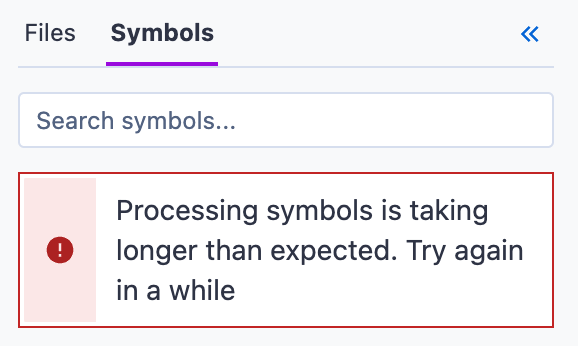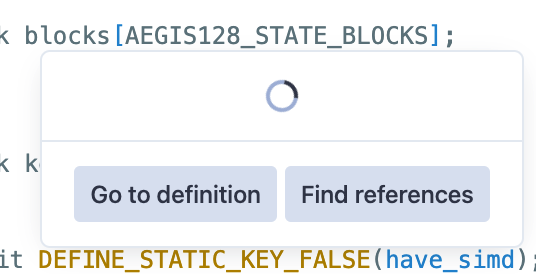Rockskip: fast symbol sidebar and search-based code navigation on monorepos
Rockskip is an alternative symbol indexing and query engine for the symbol service intended to improve performance of the symbol sidebar and search-based code navigation on big monorepos. It was added in Sourcegraph 3.38.
When should I use Rockskip?


If you regularly see the above error or slow hover popovers (when not using precise navigation), it probably means that the default implementation (which copies SQLite DBs for each commit) is not fast enough and that Rockskip might help.
A very rough way to gauge if Rockskip will help is if your repository has a 2GB+ .git directory, 50K+ commits, or 50K+ files in the working tree.
You can always try Rockskip for a while and if it doesn't help then you can disable it.
How do I enable Rockskip?
Step 1: Set environment variables on the symbols container:
For Docker Compose:
services: symbols-0: environment: # 👇 Enables Rockskip - USE_ROCKSKIP=true # 👇 Uses Rockskip for all repositories over 1GB - ROCKSKIP_MIN_REPO_SIZE_MB=1000
For Helm:
# overrides.yaml symbols: env: # 👇 Enables Rockskip USE_ROCKSKIP: value: "true" # 👇 Uses Rockskip for all repositories over 1GB ROCKSKIP_MIN_REPO_SIZE_MB: value: "1000"
For Kubernetes:
# base/symbols/symbols.Deployment.yaml spec: template: spec: containers: - name: symbols env: # 👇 Enables Rockskip - name: USE_ROCKSKIP value: "true" # 👇 Uses Rockskip for all repositories over 1GB - name: ROCKSKIP_MIN_REPO_SIZE_MB value: "1000"
For all deployments, make sure that:
- The
symbolsservice has access to the codeintel DB - The
symbolsservice has the environment variables set - The
codeintel-dbhas a few extra GB of RAM
Step 2: Kick off indexing
- Visit your repository in the Sourcegraph UI
- Click on the branch selector, click Commits, and select the second most recent commit (this avoids routing the request to Zoekt)
- Open the symbols sidebar to kick off indexing. You can expect to see a loading spinner for 5s then an error message saying that indexing is in progress with the estimated time remaining.
Step 3: Wait for indexing to complete. You can check the status as before by refreshing the page, opening the symbols sidebar, and looking at the error message. If you are interested in more technical details about the status, see the instructions below.
Step 4: Open the symbols sidebar again and the symbols should appear quickly. Hover popovers and jump-to-definition via search-based code navigation should also respond quickly.
That's it! New commits will be indexed automatically when users visit them.
How long does indexing take?
The initial indexing takes roughly 4 hours per GB of the .git directory (you can check the size with du -sch .git). Once the full repository has been indexed, indexing new commits takes less than 1 second most of the time.
What resources does Rockskip use?
Rockskip stores all data in Postgres, and the tables it creates use roughly 3x as much space as your .git directory, so make sure your Postgres instance has enough free disk. Rockskip indexes every symbol in the entire history of your repository and makes heavy use of Postgres indexes to make all kinds of queries fast, including: path prefix queries, regex queries with trigram index optimization, file extension queries, and the internal commit visibility queries.
Rockskip is completely single-threaded when indexing a repository, but multiple repositories can be indexed at a time. The concurrency is limited by MAX_CONCURRENTLY_INDEXING, which defaults to 4.
Rockskip heavily relies on gitserver for data. Rockskip issues very long-running git log commands, as well as many git archive calls.
How do I check the indexing status?
The easiest way to check the status of a single repository is to open the symbols sidebar and wait 5s for an error message to appear with the estimated time remaining.
For more info, the symbols container responds to GET requests on the localhost:3184/status endpoint with the following info:
- Repository count
- Size of the symbols table in Postgres
- Most recently searched repositories
- List of in-flight indexing and search requests
For Kubernetes, find the symbols pod and exec a curl command in it:
$ kubectl get pods | grep symbols
symbols-5ff7c67b57-mr5h4
$ kubectl exec -ti symbols-5ff7c67b57-mr5h4 -- curl localhost:3184/status
This is the symbols service status page.
Number of repositories: 1
Size of symbols table: 3253 MB
Most recently searched repositories (at most 5 shown)
2022-03-11 05:48:58.890765 +0000 UTC github.com/sgtest/megarepo
Here are all in-flight requests:
indexing github.com/sgtest/megarepo@14a3d9849ba587d667efbc542cf0c7cd106c3e72
progress 9.53% (indexed 49151 of 515574 commits), 36h55m18.227079912s remaining
Tasks (14006.77s total, current AppendHop+): AppendHop+ 44.76% 49152x, InsertSymbol 18.67% 1997101x, AppendHop- 12.94% 49151x, UpdateSymbolHops 7.78% 825380x, parse 4.01% 369401x, GetCommitByHash 2.73% 515574x, get hops 2.39% 49152x, ArchiveEach 2.26% 98302x, GetSymbol 1.83% 325351x, CommitTx 1.26% 49151x, DeleteRedundant 0.79% 49151x, InsertCommit 0.30% 49152x, Log 0.28% 1x, RevList 0.00% 1x, iLock 0.00% 1x, idle 0.00% 1x,
holding iLock
In this example you can see there's 1 repository and the symbols service has indexed 9% of all commits with an ETA of 36H from now. There's also a breakdown of tasks that are part of Rockskip's internal workings mostly for Sourcegraph engineers, so you can ignore that.
When is indexing triggered?
Indexing is triggered upon opening the symbol sidebar or hovering on a token. Both of those UI features hit the same type:symbol search API which is serviced under the hood by Rockskip.
Rockskip indexes the new commits since the previously indexed commit, so if it's been a long time since a user last opened the symbol sidebar then Rockskip will take longer to process before it can service queries. Simply opening the symbol sidebar more frequently (e.g. via having more users on the instance) will decrease the probability of seeing the still-processing message.
How does it work?
For a deeper dive into the index and query structures, check out the explanatory RFC.